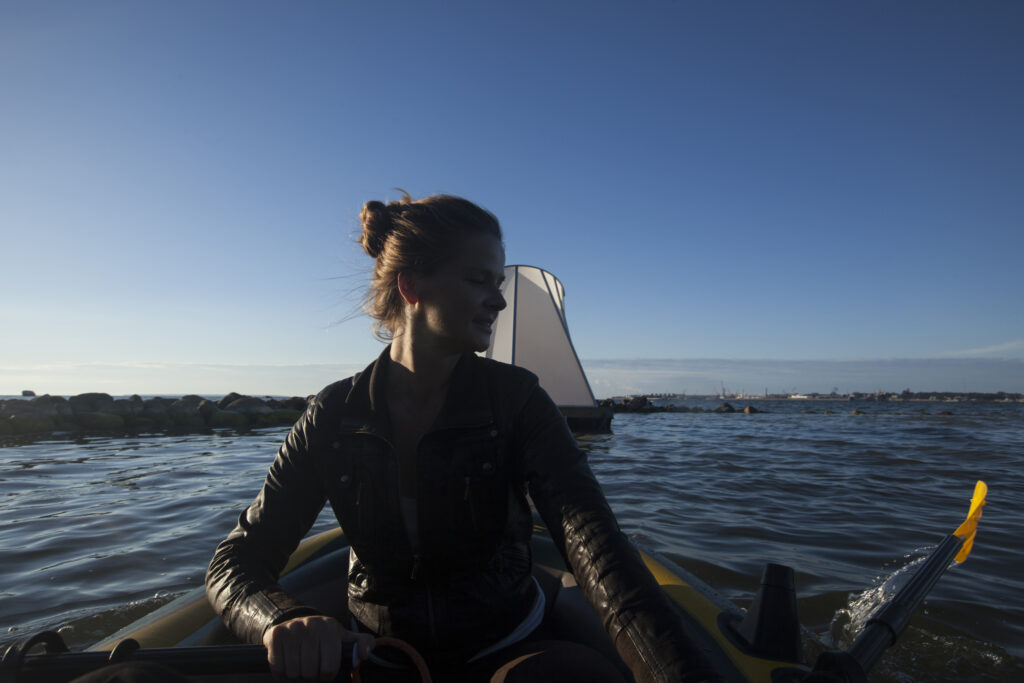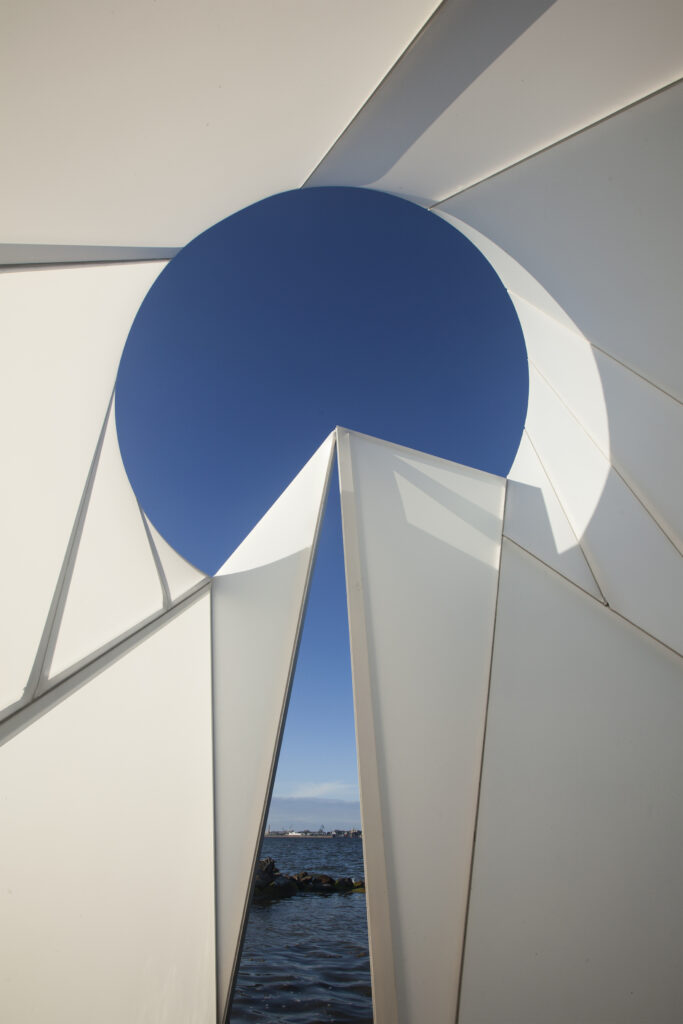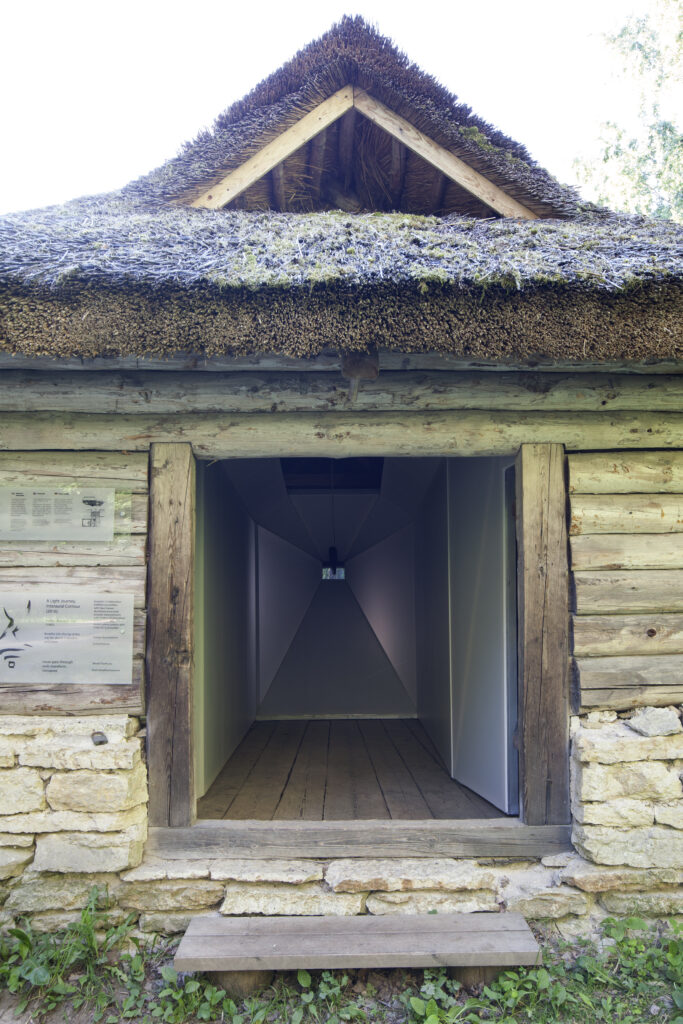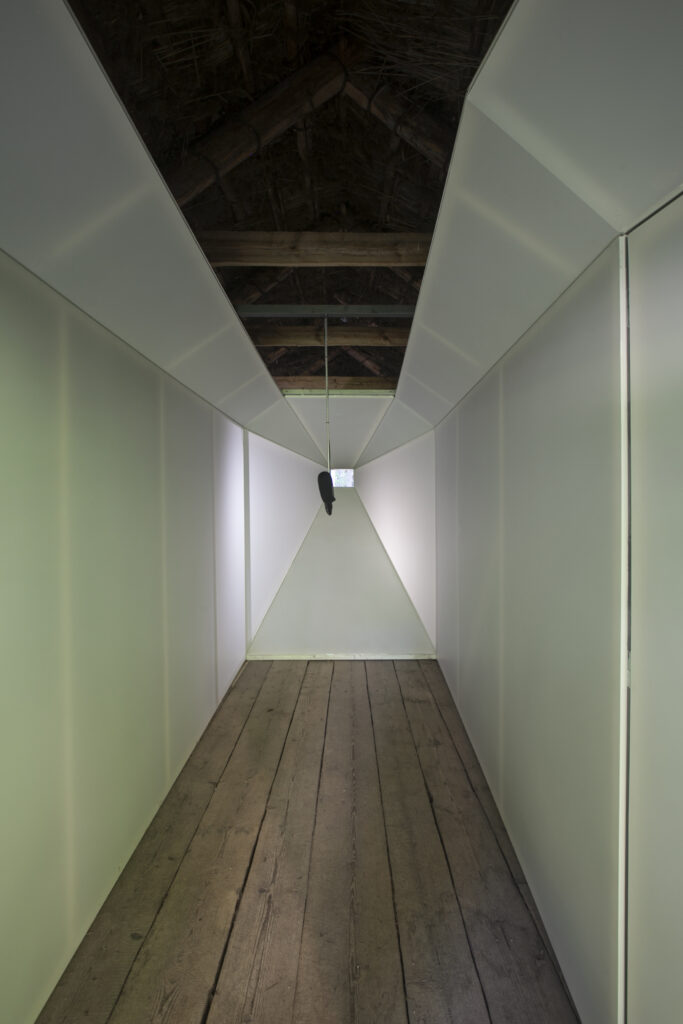THE ELEMENTS OF META-TALU
Author: Marianne Jõgi
Exhibition team: Gerda Kaasik (Akukon OY Eesti filiaal), Sten Jõgi, Haiko Sepping and Lenari Lanno (Laestuudio), Tim Püvi (Tormitehnika OÜ), Taavi Suisalu, Martin Vällik
Sponsor: Outset Eesti
The project ‘Elements of Meta-Talu’is part of the programme dedicated to the 60th anniversary of the Estonian Open Air Museum
As part of her research for PhD thesis, Marianne Jõgi designs and builds objects which on the surface appear as installation art, yet on a deeper level raise meaningful questions about architecture.
Bodily presence
Everyone who is alive is so nested in an environment. This is a condition of existence forced upon all beings whom the evolution has brought to life, no-one has ever managed to ascend to the plane of pure incorporeal existence. Indeed, before we humans invented our language games, the strange idea of existence without environment (as pure consciousness, god, spirit of the world, etc.) never crossed anyone’s mind.
Many modern consciousness theories assume bodily presence to be a part of the consciousness-forming process. To paraphrase the archaeologist Bjørnar Olsen: for the consciousness to exist, it should be made first. And what can consciousness be made of? Nothing but corporeality, tissues and organs, and the ways these connect and interact with the external environment.
Structures inside of which one can exist always remain external to the consciousness and the body. They are parts of the environment, not parts of the sentient being. As such, they are also always semiotically unfamiliar. (I need to make it clear―when discussing semiotic content, I do not construe semioticity as based on language-embedded meaning, which regrettably happens frequently. According to the Peircean notion of the reality’s semioticity, every wordless encounter with a physical object and material amounts to a semiotic experience.) In order to be able to endure the contact with the semiotically unfamiliar, the unfamiliar entity needs to have relatable properties which are perceived as physically comfortable. The use of human language as a tool for communicating with reality remains rather limited, most of the time we still rely on analogue coding, listen to the acoustic tissue of our surroundings and make physical contact with materials. At the same time, without boundary structures, external environment is mostly barely habitable―we must constantly seek shelter inside something physically comfortable (clothes and rooms).

Marianne Jõgi’s objects which we observe here are gathered under the title ‘Elements of Meta-Talu’ Both accentuate certain possible aspects relating to the physical comfort afforded by the indoor environment.
Objects looking at the sky
Marianne Jõgi’s objects are often technically complex. Their assembly cannot be accomplished without a knowledge of metalworking and electronics. As a unique feature, they obtain their input from the surrounding environment or the observer and transform it into a feedbacked experience.
In terms of its shape, ‘Interaural Contour I’ is a cone which opens to the sky and appears as if looking at it. Numerous objects exist which look at the sky, as intended by their design and purpose. Telescopes, for instance, are such objects. Yet telescopes have a strictly defined functionality. Our objects, belonging to the grey area where art meets technology, slip outside the confines of clear-cut functionality. Technology itself, defined by its practical purpose, is allowed no such freedom―if it does not work, then it is faulty and will be fixed. An improvement in technology is certainly good, but in most cases it does not add any extra-definitional layers to the object. It is more interesting if the identity boundaries begin to dissolve and ambiguity comes into play.
Coming to the unique feature of Marianne Jõgi’s objects―they are acoustically active. Acoustic activity cannot be easily determined, since the readings of a measuring instrument and the psychoacoustic perception of a sentient do not necessarily correlate. Externally, the object ‘A Light Journey. Interaural Contour’ simply appears as an old talu building. The electronics incorporated in the building listen to the breathing sounds of the entering person and use them to create the building’s acoustic surroundings. The listener is both inside and outside at the same time. And the indoor room with carefully selected acoustic parameters, relying on interaural hearing differences, attempts to create a physically comfortable listening experience.
The answer to the question whether it is comfortable to be inside the object is never easily predicted at the level of individuals. Even with the speed afforded by modern construction technologies, the building of an architectural object still requires a great deal of time and substantial resources. Should it later transpire that the object is uncomfortable for those inside, what then? With a smaller experimental object, such problems are avoided. It can be built quickly. It can be moved. The experience it offers is chiefly experimental―and experience is exactly the reason why people come to the object. Marianne Jõgi’s objects function precisely in this manner―as an experimental laboratory of acoustic reality.

A technological tipi
One of the objects of this article could be described as a technological tipi (‘Interaural Contour I’). The last time I knew this white conical polyhedron-like structure could be found floating on the sea surface near the Estonian Open Air Museum. Likewise, a tipi of the Indians stood in an open prairie field, the winds howling around it and its skin stretched on the frame, not unlike that of a drum that can be beaten. Through the opening at the top, one could gaze at the North Star. In addition to Polaris, the arch opening from within the ‘Interaural Contour I’ follows the visible celestial summer trajectory of Vega. Earth’s slow axial precession causes the change of its pole stars, with Vega and Polaris at opposite ends from each other. One full spin takes nearly 26,000 years for Earth to complete. This cycle is known as the platonic world-year, or cosmic year.
A tipi of the era of technological advancement need not be a portable dwelling with the functionality of a traditional tipi. A technological tipi can be an object that mainly reminds us of how everything once was―how it felt to gaze at the stars through the opening at the top and to realise that the only thing separating you from the icy immense blackness of the universe is a thin animal skin or a piece of cloth. Such an object can bring forth certain properties of a real tipi to be experienced.
The object ‘Interaural Contour I’ is a device that unpacks and presents the structure of the experience of being in a tipi. It recreates the bodily experience which the person in truth might not even have, but which is still imparted due to a certain structural similarity. And it also accentuates the details of the perception of one’s presence and surroundings. In order to fully grasp the functionality of this object, one should stay in it for a longer while. Preferably for hours. Both day and night―the stars must not be missed. With different winds, howling and wailing behind the white wall. With different colours of the sky. This object has stood firm on the ground and floated above the water. Undulating waves, clouds gliding across the sky, reverberating walls. All of this is part of the object’s functionality. As such, it is placed somewhere between an art object and an architectural object, it is almost habitable, yet still too open to the external environment to allow permanent habitation. One should come and stay, yet one must also leave after a certain while.
The question it raises is this―whether the dwelling space, where people spend so many years of their lives, could exhibit more variety? Should it be necessary to pay more conscious attention to diversity in their form? Straight walls and right angles are the dominant norm of our culture, yet could the rigidity of this standard be lessened even if by just a few curved lines? Agreed, people are an immense multitude and standards have developed in response to certain necessary practicalities and rational considerations, one cannot easily deny that. Yet on a smaller scale, thinking of the possible preferences of a single individual―shouldn’t we introduce more variety into the shape of our rooms? When the disciples of Buckminster Fuller began to build geodesic domes, it appeared first that the shape of the dome solved a large number of problems related to sense of comfort and construction techniques as inherent in traditional rectangular structures. After a while, a new set of different problems was revealed instead, cancelling the glorious revolution in the history of building construction. The domes did not become a standard and, now living in what is a distant future if observed from the 1950s, we can attest that the huge fields of curved shapes and domes, as imagined by the artists waiting for the perfect future, have not materialised. Yet the question remains―can we find any solutions through changing the form? Something which we could perhaps look for in the lower drawer of less-used standard solutions? The ‘Interaural Contour I’ indeed also points in that direction.


Each pop and crackle
The second question, to which answers remain even more elusive, concerns the acoustic parameters of living rooms. Of course, the standards which the living rooms must conform to also exist here. Yet how much, if at all, do we think of the acoustic properties of a room as of something that can have a significant impact on our sense of comfort? Could it be that the design of personal room acoustics becomes a standardised process in future architectural design? This is exactly the possibility hinted at by the ‘Elements of Meta-Talu’―the room whose acoustic character constitutes an important component of the experience of being in the room. Materials whose acoustic properties have been calculated and tested. This calculating and testing had a definite goal and purpose―to build a room one would feel comfortable to be in. For that feeling to be clearly perceptible and physical.
If constant acoustic interaction takes place between the room and the sentient being inside the room, then how important is that for the sentient being’s sense of comfort? To what extent the pleasantness or repulsiveness of the room depends on its acoustic parameters? And how much would it be possible in architectural processes to consciously engage in the design of acoustics with the personal needs of human and animal beings in mind?
Marianne Jõgi’s works suggest that the room acoustics should also be put on the table along with the strength calculations of structures, health and safety considerations of materials and other alike matters. The acoustic feedback of materials and rooms is that part of the room which reverberates with each uttered word, each pop and crackle. It is ever-present while we are present. And much in this area yet needs to be studied and discovered.

ANDRUS LAANSALU investigates the problems of art history in the framework of biosemiotics. He works with sounds. He has studied biology at the University of Tartu, while he currently pursues his PhD degree at the Estonian Academy of Arts where he also teaches.
1 Talu’ is a traditional Estonian peasant dwelline complex.
COMMENT
Kaja Pae: How do you achieve the pleasant acoustics of your installations and how do you assess the influence of the structure’s geometry and materials?

Marianne Jõgi: The sound waves reaching our ear are converted in the inner ear into electrical impulses which travel along the auditory pathways to the brain, from the brainstem to the cortex, thus forming our subjective hearing experience in the process. The research conducted to study these underlying mechanisms also forms the basis for the subjective preference theory1 whose goal is to study the formation of acoustic experience and to learn how to create a pleasant acoustic environment. This theory, which today is applicable to the built environment in a wider sense, grew out of research conducted in order to improve individual listening experience in concert halls and links neuroscientific evidence with the geometry of space.
The empirical research in support of the theory has demonstrated that the subjectively pleasant sound field induces alpha waves (8–13 Hz) in the brain. The occurrence of these neural oscillations in the brain is associated with relaxation, sense of well-being, creativity and improved learning ability. This means that the sound signal and the sound field which is formed of its reflections as an input influences the brain activity, which in turn directly influences the rest of the organism, including the individual’s perceptions and supposedly behaviour. The properties of the sound input can be modified by the geometry of space and choice of materials (the geometry here plays a substantially more important role). In certain situations, the change of just a few degrees in the tilt of the reflecting surface can optimise the acoustic environment (difference in arrival time of a sound between two ears is a significant factor). Since the parameters employed by the theory are either temporal or spatial, affecting respectively the left and right hemispheres of the brain, the same signal analysis techniques have been adopted for the analysis of visual input (pulsing light and textures). Mapping experiences that arise from the interface of body and consciousness enables creating links with the surrounding space. We can use this knowledge for improving our living environment.
The subjective preference theory has been developed and applied by the Japanese acoustician Yoichi Ando who is also the supevisor of Marianne Jõgi’s PhD thesis.
HEADER photo by Kristina Õllek. “Interaural Contour I, 2017
PUBLISHED in Maja’s 2018 spring edition (No 93).





